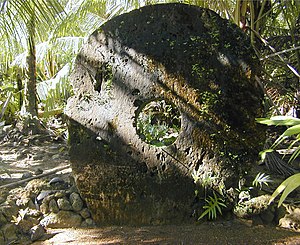Rai stones
Rai stones are large, circular stone disks carved out of limestone in the island of Yap, Micronesia. Locals have used these stones as a form of unusual currency, a "stone money."

Form and value
Rai stones are circular disks carved out of limestone with a large hole in the middle. The size of the stones varies widely; the largest are 3 meters (10 ft) in diameter, 0.5 meters (1.5 ft) thick and weigh 4 metric tons (8000 lb).
The extrinsic (perceived) value of a specific stone is based not only on its size and craftsmanship but also on the history of the stone. If many people - or no one at all - died when the specific stone was transported, or a famous sailor brought it in, the value of the rai stone increases.
Rai stones were used in social transactions like marriages, inheritance, political deals, sign of an alliance, ransom of the battle dead or just in exchange for food. Many of them are placed in front of meetinghouses or specific pathways. Though the ownership of a particular stone changes, the stone itself is rarely moved. The names of previous owners are passed down to the new one.
History
Yapese quarried the limestone rocks from the islands of Palau and took them to Yap with canoes and rafts. Local legend holds that the Yapese discovered the rock of Palau about 500-600 years ago when an expedition led by a man called Anagumang landed on Palau. Limestone was nonexistent in Yap and therefore very valuable to the Yapese.
First Anagumang ordered his men to cut stone into the shape of fish but eventually a circular shape was chosen, probably because it was easier to transport. A pole was put through the hole in the center of the stone so that laborers could carry the stone. The largest of the disks probably needed hundreds of men to transport.
Residents of Palau, in turn, required Yapese to pay in beads, coconut meat and copra or in the form of services for the privilege of quarrying.
In 1871 an Irish-American David Dean O'Keefe was shipwrecked near Yap and was helped by the natives. Later he assisted the Yapese in acquiring rai and in return received copra and trepang, which were valuable exports in the Far East. He provided the Yapese with iron tools. As a result, a form of inflation set in (literally) and rai stones acquired with his help were less valuable than more ancient ones.
The trade for rai stones eventually stopped at the beginning of the 20th century due to trade disputes between Spanish and German interests in the area. Quarries were abandoned. When Imperial Japanese forces took over Yap during World War II, they used some of the stones for construction or as anchors.
Although Western-style money has replaced the stones as everyday currency, the rai stones are still exchanged in traditional ways between the Yapese. They are a national symbol and are depicted on local license plates.
